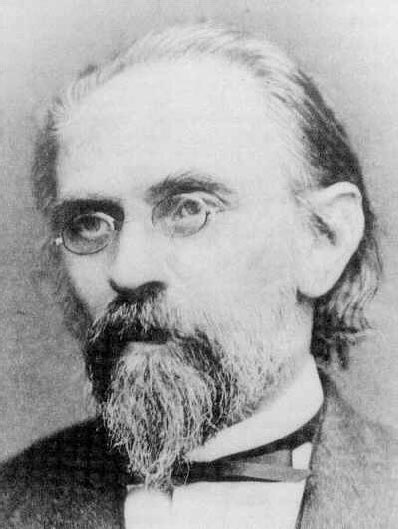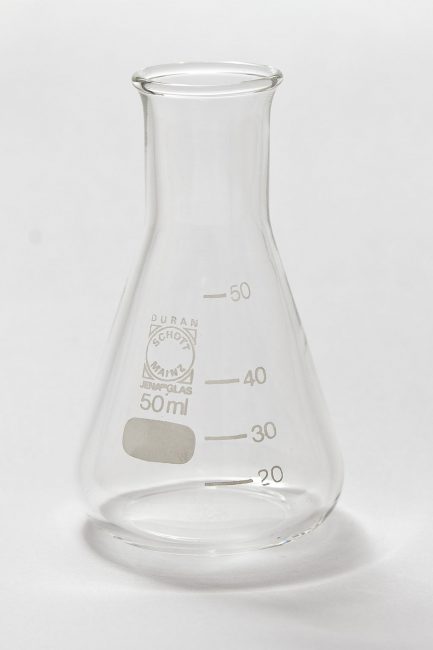
Richard August Carl Emil Erlenmeyer (1825-1909)
On June 28, 1825, German chemist Emil Erlenmeyer was born. Erlenmeyer is known for contributing to the early development of the theory of structure, formulating the Erlenmeyer rule, and especially for designing the Erlenmeyer flask, a type of chemical flask, which is named after him. Actually, I remember the Erlenmeyer flask from my earliest chemistry lessons back in high school. So, who was the man behind that prominent gadget?
Emil Erlenmeyer – Early Years
Richard August Carl Emil Erlenmeyer was born in Wehen, Duchy of Nassau (today Taunusstein, Hesse, near Wiesbaden), the son of a Protestant minister. He enrolled in the University of Giessen to study medicine, but after attending lectures of Justus von Liebig,[3] who made major contributions to agricultural and biological chemistry, and was considered the founder of organic chemistry, Erlenmeyer changed to chemistry. In the summer of 1846 he went to Heidelberg for one year, and studied physics, botany and mineralogy, returning to Giessen in 1847. After serving as assistant to H. Will and then to Carl Remigius Fresenius,[4] who was reknown for his studies in analytical chemistry, Erlenmeyer decided to devote himself to pharmaceutical chemistry. For this purposes he studied in Nassau, where he passed the state pharmaceutical examination, and shortly afterwards acquired an apothecary’s business, first at Katzenelnbogen and then in Wiesbaden. He became dissatisfied with pharmacy and returned to chemistry, finishing his doctorate at Giessen in 1850.
Working with Bunsen and Kekulé
In 1855 he moved to Heidelberg to work on fertilizers in the laboratory of Robert Bunsen,[5] who had developed several gas-analytical methods, was a pioneer in photochemistry, and did early work in the field of organoarsenic chemistry. Erlenmeyer wished to teach, but Bunsen’s associates were not allowed to take private students. Therefore, with his wife’s help, he converted a shed into a private laboratory. In 1857 he became privatdocent and his habilitation thesis “On the manufacture of the artificial manure known as superphosphate” contained a description of several crystalline substances which greatly interested Robert Bunsen. It was while at Heidelberg that Erlenmeyer was brought under the influence of August Kekulé,[6] one of the most prominent chemists in Europe, especially in theoretical chemistry, whose theoretical views he was one of the first to adopt. He was the first to suggest, in 1862, that double and triple bonds could form between carbon atoms, and he made other important contributions to the development of theories of molecular structure.

Erlenmayer Flask
The Erlenmeyer Rule
In 1863 Erlenmeyer became associate professor at the University of Heidelberg until 1868, when he succeeded to become full professor at the new Munich Polytechnic School, a post which he held until his retirement from teaching in 1883. His work mostly focused on theoretical chemistry, where he suggested the formula for naphthalene and in 1880 formulated the Erlenmeyer rule: alcohols in which the hydroxyl group is attached directly to a double-bonded carbon atom become aldehydes or ketones. This conversion occurs because the keto form is, in general, more stable than its enol tautomer. The keto form is therefore favored at equilibrium because it is the lower energy form.
Hydrolysis
Erlenmeyer’s practical investigations include conducted hydrolysis of ether to alcohol reaction, synthesized aminohexoic acid in the year of 1859, discovered the nature of glycides in the year of 1860, isolated glycolic acid from unripe grapes in the year of 1864, synthesized sodium oxalate by heating sodium formate in the year of 1868, synthesized phenyl-lactic acid in the year of 1880, prepared pyruvic acid by the distillation of tartaric acid in the year of 1881. In 1882 he synthesized tyrosine an aromatic aminoacid from phenylalanine and also worked on isomerism of the cinnamic acids.[2]
Atomic Theory
Erlenmeyer contributed a lot to the spread of atomic theory. At an early age, he dealt extensively with the structure of chemical compounds and debated with his colleagues. Since he had worked as a part-time editor of the journal for chemistry, pharmacy and mathematics since 1859, he was able to put his theories up for discussion here at an early stage. In 1862, on the basis of his investigations, he was the first to discover that there were not only single bonds, but also multiple bonds. In this way he contributed significantly to the recognition and understanding of the structure of many compounds. In addition, in his publications he always used the current Coupersian spelling for structural formulas, thereby helping it to achieve a breakthrough.
The Erlenmeyer Flask
In 1860 he published a description of the conical flask that bears his name. An Erlenmeyer flask, also known as a conical flask or titration flask, is a type of laboratory flask which features a flat bottom, a conical body, and a cylindrical neck. Erlenmeyer flasks have wide bases, with sides that taper upward to a short vertical neck. They may be graduated, and often spots of ground glass or enamel are used where they can be labeled with a pencil. It differs from the beaker in its tapered body and narrow neck. Erlenmeyers are also used other than chemistry laboratories, such as microbiology labs for the preparation of microbial cultures. Plastic Erlenmeyer flasks used in cell culture are pre-sterilized and feature closures and vented closures to enhance gas exchange during incubation and shaking. [2]
Emil Erlenmeyer died on January 22, 1909, at age 83.
Paul Andersen, Acid-Base Equilibrium, [11]
References and Further Reading:
- [1] “Erlenmeyer, Richard August Carl Emil.” Complete Dictionary of Scientific Biography. . Encyclopedia.com
- [2] Emil Richard Erlenmeyer – discoverer of Erlenmeyer flask, World of Chemicals
- [3] Justus von Liebig and the Agricultural Revolution, SciHi Blog
- [4] Carl Remigius Fresenius and the Analytical Chemistry, SciHi Blog
- [5] Robert Wilhelm Bunsen and the Bunsen Burner, SciHi Blog
- [6] August Kekulé and the Carbon Ring Structure, SciHi Blog
- [7] Emil Erlenmeyer at Wikidata
- [8] Emil Richard Erlenmeyer at Reasonator
- [9] B. Lepsius (1921). “Nekrolog: Friedr. Gustav Karl Emil Erlenmeyer 1864–1921”. Berichte der Deutschen Chemischen Gesellschaft (A and B Series). 54 (5): A107–A113
- [10] Otto N. Witt (1911). “Emil Erlenmeyer, 1825–1909”. Journal of the Chemical Society, Transactions. 99: 1646–1668
- [11] Paul Andersen, Acid-Base Equilibrium, Bozeman Science @ youtube
- [12] Berthold Peter Anft: Erlenmeyer, Richard August Carl Emil. In: Neue Deutsche Biographie (NDB). Band 4, Duncker & Humblot, Berlin 1959, ISBN 3-428-00185-0, S. 594 f.
- [13] Timeline of German Chemists, via DBpedia and Wikidata






Pingback: Whewell’s Gazette: Year 3, Vol. #46 | Whewell's Ghost
Pingback: Emil Erlenmeyer • Biografias • Quimicafacil.net